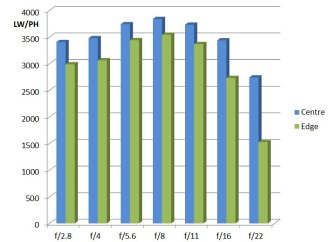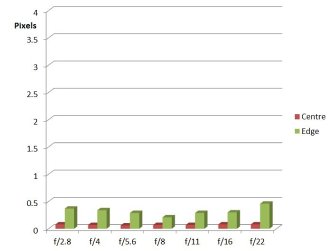Laowa 12mm f/2.8 Review
Laowa 12mm f/2.8 Performance
When we look at sharpness we see impressive results. Centrally the lens is excellent from open aperture all the way through to f/16. It tails off very slightly at f/22, but still delivers a very good standard. The edges are, unsurprisingly, slightly behind, but start off at a very good level at f/2.8 and f/4, becoming excellent by f/5.6 and holding that excellence to f/11. Results are still very good at f/16 but do fade to only being fairly sharp at the edges at f/22. This is particularly impressive when we consider that the lens had to be placed very close to the test chart, something that it is not really designed for, and it still managed to excel.
How to read our charts
The blue column represents readings from the centre of the picture frame at the various apertures and the green is from the edges.The scale on the left side is an indication of actual image resolution as LW/PH and is described in detail above. The taller the column, the better the lens performance.
For this review, the lens was tested on a Nikon D810 using Imatest.
CA (Chromatic aberration) is amazingly low for any lens, never mind such a wide one. Centrally the figures approach zero and even at the edges barely nudge one third of a pixel. In very demanding shots a slight amount of CA may be seen, but this is unlikely to be noticed and the result is as good as some of the very best lenses.
How to read our charts
Chromatic aberration is the lens' inability to focus on the sensor or film all colours of visible light at the same point. Severe chromatic aberration gives a noticeable fringing or a halo effect around sharp edges within the picture. It can be cured in software.Apochromatic lenses have special lens elements (aspheric, extra-low dispersion etc) to minimise the problem, hence they usually cost more.
For this review, the lens was tested on a Nikon D810 using Imatest.
Flare is also well under control and is not evident on any of the shots made against the light. This is extremely important in a lens where the front element is so exposed, so all due credit to the quality of the coatings used.
One of the main features of the lens is its rectilinear properties and distortion is very low at -0.98% barrel. This is much better than most lenses and commendable in one as wide as this.
Bokeh is very much on our minds with modern lenses, but in the case of the Laowa 12mm f/2.8 the emphasis is quite likely to be on extensive depth of field, with sharpness throughout the image. Not necessarily of course, and when there is any defocused background the bokeh is smooth and pleasant enough.
Value For Money
The current price of the Laowa 12mm f/2.8 lens is $949. When we look at the market we see that there are really very few full frame lenses that fall into the same bracket. The Canon EF 11-24mm f/4 L USM is as wide, but not as fast, and costs £2799.
There are a few 14mm f/2.8 lenses, but the difference between that and 12mm is really quite marked. The Canon EF 14mm f/2.8 L II USM is priced at £1599, the Samyang 14mm f/2.8 ED AS IF UMC at just £299.
My conclusion is that the lens is more or less unique, delivers the quality needed and is reasonably priced. That price may yet fall with time.
For more options have a look at the Top 15 Wide-angle Lenses.
Add your message
Please login here or if you've not registered, you can register here. Registering is safe, quick and free.
photodo Stats
428 MTF tests
74 in-depth photodo reviews
100+ users join each day
Help the lens community by reviewing or rating a lens today via our lens search
Latest Lens Reviews
- Chinon 28mm f/2.8 Vintage Lens Review
- Canon EF 70-200mm f/4L IS II USM Lens Review
- Samyang AF 85mm f/1.4 EF Review
- Sigma 70mm f/2.8 DG Macro Art Review
- Samyang AF 24mm f/2.8 FE Review
- Meike 50mm f/1.7 Review
- Tamron 70-210mm f/4 Di VC USD Review
- Lensbaby Burnside 35mm f/2.8 Review
- Asahi Super Takumar 50mm f/1.4 Review
- Asahi Super-Multi-Coated Takumar 135mm f/3.5 Review


